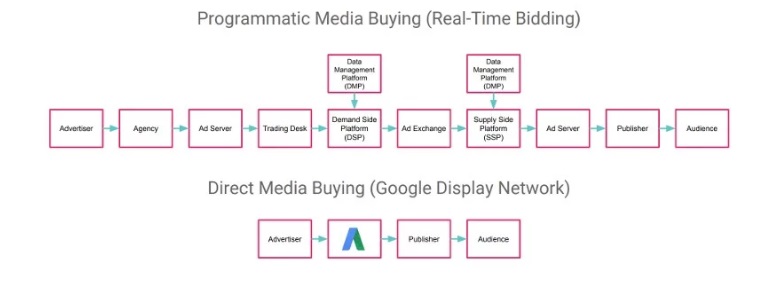Programmatic Vs Display Network Advertising: What’s the Difference?

Key takeaways:
- Programmatic advertising automates ad space buying across various exchanges, while display networks serve ads within closed ecosystems.
- Programmatic ads offer broader audience reach and efficient real-time bidding, whereas direct display networks have limited reach within their closed networks.
- Programmatic native ads blend seamlessly into content, with richer targeting options based on extensive user data compared to display networks.
- Programmatic dominates digital ad spending, forecasted to reach $800 billion by 2028. Despite this, display networks are still a key channel for digital marketers, especially in niche markets yet to embrace programmatic advertising fully.
Programmatic vs Direct Display Advertising: The Showdown
One of the characteristics of the digital marketing industry is a penchant for jargon.
The ever-growing range of tools and tactics in digital marketing brings a lot of complicated-sounding terminology with it.
One of these has been around so long and has become so ubiquitous, that it is no longer strange sounding to anyone: programmatic advertising.
But is programmatic the same as display network advertising? What are programmatic display ads, if not regular display ads?
To clear up any leftover confusion, let’s go back to basics, and compare programmatic vs direct display – what they are, how they are used, how they are different, and what advantages they offer. Here goes!
What is Display Network Advertising?
Display advertising is one of the ‘oldest’ types of online advertising, having been around since the mid-1990s. Display ads come in the form of banners, in different sizes, which are served to online audiences via display ad networks. Google’s ad platform, the Google Display Network (GDN), is one of the most well-known – according to Google, it has over 2 million websites, videos, and apps in which ads can appear, and reaches more than 90% of people on the internet. But there are plenty of other display ad networks, including Microsoft Advertising (Bing Display Ads), AdPushup, and dozens more. Learn more about how display advertising works in this article about native vs display advertising.
What is Programmatic Advertising?
Programmatic display advertising is not an ad network – rather it is an automated way of buying advertising space via algorithm-based technology to get the most accurate ad placement in the fastest time at the best price. Programmatic advertising is sold via ad exchanges. Publishers offer ad space to be bought programmatically, and advertisers enter automated bids to buy programmatic ad space in real-time according to advanced analytics that help determine where to place the ad and get the most impressions for the best bid. It’s all done in an instant on an ad exchange, of which there are dozens. Here’s a deeper look at how programmatic advertising works.
What Are the Differences – and Advantages?
While display network advertising takes place on a single closed network, programmatic is a method of buying ad space on multiple ad exchanges at once. Both display network and programmatic advertising use advanced data analytics and software to get the most effective ad placement. However, given the vast inventory covered by programmatic advertising, the process involved is much more complex.
The image below gives a great visual overview of the linearity of direct media buying typical of display network advertising versus the programmatic method.

So what are some of the differences between programmatic vs direct display advertising? Let’s take a look:
Reach
A key difference between display network ads and programmatic display ads is audience reach. Display networks are closed advertising ecosystems – although huge, they are limited to the websites that are part of their network. Programmatic advertising is a platform that covers inventory from multiple ad exchanges, supporting a truly massive inventory that expands the advertiser’s potential reach, meaning ads can be seen by far more people than they otherwise would on a display network.
Type of ads
Programmatic and display network advertising platforms both support a wide variety of ad types, including video and interactive HTML5. However, while display ads look like ads, native programmatic ads do not. Native ads are designed to fit seamlessly into the design of the web page they appear on. For this reason, native advertising is an effective antidote against banner blindness, helping to boost customer engagement and brand awareness. When bought programmatically, native advertising can really supercharge performance marketing results.
Targeting options
While both display network advertising and programmatic advertising support advanced audience targeting, including remarketing and custom audiences, programmatic advertising typically provides a richer range of options. This is due to the sheer volume of user-generated data that is available for analysis via programmatic advertising. Unlike display networks, with programmatic, the advertiser is not limited to the websites in the network, so there is far more opportunity for audience segmentation and focused targeting via third-party networks.
Speed and cost efficiency
A key advantage of programmatic advertising is the automated, real-time nature of ad buying. This makes the whole process faster and more efficient. With programmatic, all the manual work of buying ad placements, targeting, and analyzing is done in an instant, via a central dashboard where the advertiser can manage and monitor their ad campaigns strategically and effectively. Programmatic removes the middleman, enabling advertisers to bid in real-time for the best ad placement at the lowest price on numerous ad exchanges at once, using AI-driven algorithms created to enhance the reliability of results.
Programmatic vs Direct Display: The Numbers
Since the earliest banner ads, digital advertising has been on a constant growth trajectory. Programmatic advertising has only accelerated the trend. Most digital ads today are bought programmatically. During the past five years, programmatic advertising has made up around 80% of all ad spend.
Programmatic advertising spending continues to rise. In 2023, it reached nearly $550 billion worldwide, forecast to hit close to $800 billion by 2028.
Programmatic video is also growing at a fast pace. In 2023, programmatic video ad spending was a whopping $74 billion, expected to rise to $96 billion in 2025. Programmatic advertising is even taking over OOH (out-of-home) advertising, like billboards and kiosks. In H1 2023, 41% of OOH advertising was bought programmatically.
While the shift towards programmatic display ads is clear, display network advertising still has a strong place in the toolbox of digital marketers. This is particularly so in industries where programmatic has yet to take a substantial share of ad spending away from direct display, such as education and cooking.
So when it comes to programmatic vs direct display, the real challenge is when, where, and how to use each to boost your ROI and maximize your online advertising results.











